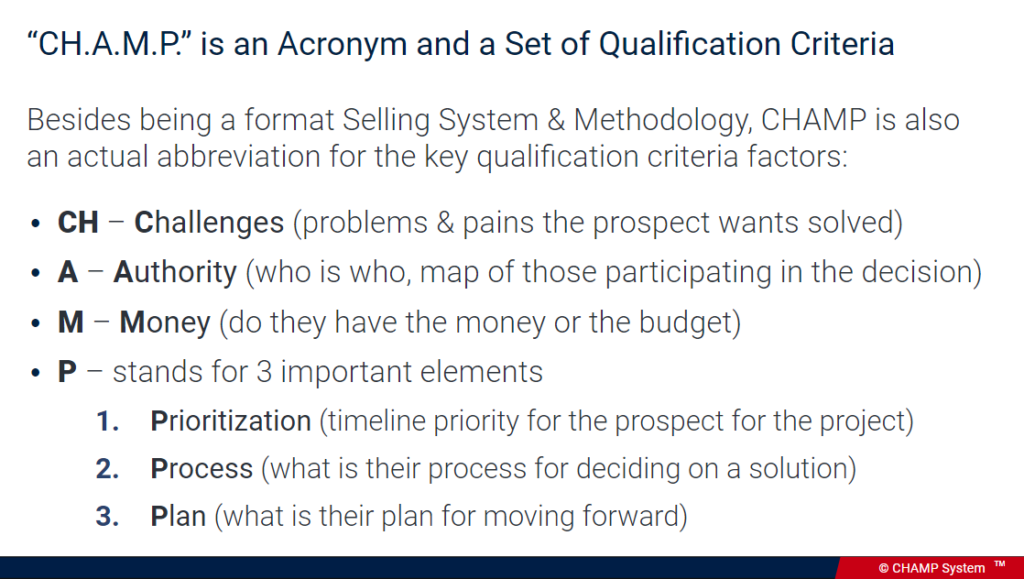

CHAMP Sales – Selling Qualification Methodology
The CHAMP Sales System Qualification Criteria
Here is a summary of the CHAMP Qualification Criteria and you can find some example questions below.
The best way to align with your Buyer – is to ask them questions and actively listen with the goal of being helpful and adding value in solving the Challenges of your buyer.
Challenge Questions:
- What challenges is your business facing and what problems do you need to solve?
- What is driving your interest in our solution?
- How long have you had this challenge or problem? What made you decide to solve this problem now?
- What objectives are you looking to achieve by solving this pain?
- What are the likely consequences if the pain is not solved?
The answers to these questions will enable your sales team to determine whether your product or service is a match for your prospect. You’ll know you’re a match if you believe your product or service will satisfy the prospect’s needs.
Authority
Authority is not a blocker – it’s a call to action. (Tweet this!)
It is often the most misunderstood step in the lead qualification process. Many sales reps believe that “Authority” means you should disqualify leads with low-influencing contacts. NOT the case! “Authority” means you must ask your prospect questions that help you map out their company’s organizational structure.
It doesn’t matter if the initial contact on the lead has low authority – they can help you get an idea of who the decision-makers are. Who are the 5 key influencers you need to get in touch with? Are they the CEO, the CFO, the CMO, VP Sales, a Board member, a manager? Your prospect has that valuable insight, and you as a sales rep just need to find out.
Once you know who the decision-makers are, it is your job as a salesperson to reach them. I recommend reading our blog posts on how to turn low-authority contacts into customers and how to get past the gatekeeper and reach decision-makers quickly to learn tips and tactics on reaching high influencers.
Authority Questions:
- Who, in addition to yourself, is involved in making this solution happen at your company?
- How are purchasing decisions made for products like ours and who is involved in looking at this solution?
- Who in addition to yourself is the decision-maker with most clout? And next to that person, who is the next person? How important is it that they be on board with the decision?
- What concerns do you think they may have? If they have any potential concerns, how do you think we should handle them?
- Would it make sense for us to schedule a call together with them to answer any potential questions they may have?
- Are you comfortable, perhaps prior to our next meeting, if I call (Name of Decision-maker / Influencer) to have a brief conversation? My experience has been that while everyone in the organization is pretty aligned on the needs, typically everyone has got a little bit of a different perspective as to what they are looking for in a solution like this. That way everyone will have input in this. And, by the way, if I get a different perspective from him/her, would you mind if I give you a call? What I hope is that you all have a consensus as to what the solution should look like for our next meeting. Fair enough?
Money
Money is a critical factor in any buying decision. If your prospect can’t afford your product or service, you won’t be able to sell to them. Once you’ve qualified their challenges and needs, it is time to find out their expectations for the investment they’ll need to make to fulfill these needs. Have they set aside a budget to solve this challenge? If they don’t have the funds now, will they in the future? What else are they spending money on? Now is also a good time to mention the typical ROI for your product or service to remind them why the investment is worth it.
Money Questions:
- What are your expectations for the investment necessary to purchase the solution?
- Do you have a portion of your budget allocated to this?
- Is your finance team or CFO involved in approving this? (Note: While this can come off as an “Authority” type of qualifying question, it is equally indicative of how the budget approval process works at the company depending on the prospect’s answer)
- What is your typical budget allocation process from when you need to invest in a solution like this that was outside of the original budget?
- When do you plan to ask for budget allocation for this investment?
Prioritization
BANT calls this “Timing”. And timeline is a function of prioritization. When a prospect says they need to solve this problem by their next board meeting in 2 weeks, what they’re really saying is “this is a top priority.” So ask your prospect: how important is solving this problem relative to other priorities? What date or event is their priority attached to (end of month, end of quarter, by a certain event)? Is it a top priority for Q2, or is it a goal they want to solve at some point before the end of the fiscal year? If they don’t need a solution until the end of 2014, that means it is in a queue of other priorities. Find out what they are to get an idea of your prospect’s business plan.
P1 – Prioritization Questions:
- Do you currently have a contract? If so, when is it due for renewal? Is there a cancellation fee?
- When were you planning on starting the implementation?
- So when is the latest when you would want to make a decision? So you wanna have a decision made no later than 2 months. And ideally, when would prefer to get this done?
- So what’s a realistic kind of timeframe that we should be targeting here? When would you like to have have the problem solved?
- How important is this to you and where does this stack up in terms of priority and urgency? What are some of the other priorities now?
- Do you have the time and bandwidth to begin implementation now?
- Would you like to hear about how other people I’ve worked with have implemented plans like these? (If they are interested then it indicates that this is important and high on the list of priority and timeline)
Priority to Move Forward With Us vs. Competition:
- Are you looking at or evaluating any other similar solutions to help you solve the problem?
- Where do we stack up in terms of functionality and pricing when compared to these other solutions you’ve been looking at?
- What is your relationship like with your current vendor? (If they have one)
P2 – Process (Decision-Making Process):
- How do you typically decide to invest in SaaS/subscription software?
- How have you decided as a team last time to invest in a similar SaaS solution?
P3 – Plan:
- What makes sense for next steps?
